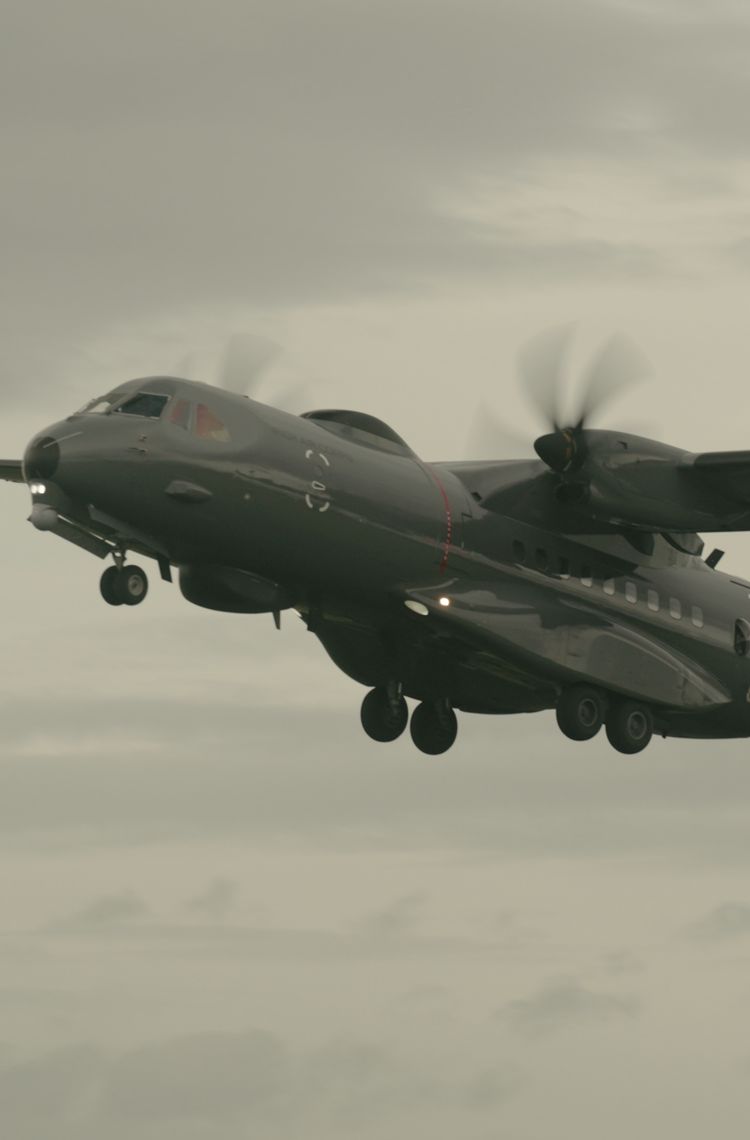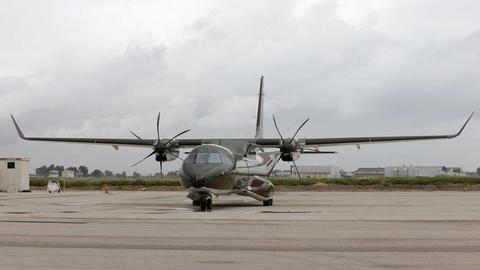The Airbus C295: many missions - one aircraft
It is a rainy morning in Casement Aerodrome, just South-West of the Irish capital of Dublin. The wind is blowing at more than 30 knots or 55 km/h. There’s a popular saying that you can experience all four seasons in Ireland in one day. Due to its exposed location in the periphery of Europe, turbulent weather is the norm rather than the exception in Ireland, so the Irish Air Corps routinely has to deal with heavy rain and strong winds. Just one of the reasons why Ireland chose the Airbus C295 MSA. Commandant Dónal Curran is optimistic, however. He believes that the weather will have improved by the time the aircraft is supposed to take off. And he is right after all.
The skies clear at noon and the sun is now shining on the Irish C295 Maritime Surveillance Aircraft (MSA) that is parked on the ramp. After the Mission Support Centre (MSC) has prepared the relevant information, such as flight planning or planning Search and Rescue patterns, they hand them over to the crew, check the aircraft, and join the pre-mission briefing. Today, the crew has planned to fly down to the southeasternmost corner of Ireland and return along the East Coast back to Dublin.
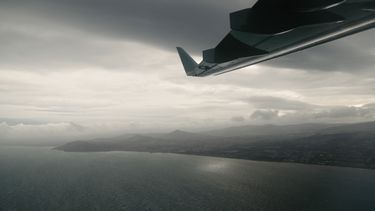
As the air arm of the Irish Defence Forces, the Irish Air Corps’ primary mission is to contribute to the security of Ireland by providing for the Military Air Defence of its airspace. Part of this includes inshore and offshore maritime patrols. They apply the rules of the European Union’s Common Fisheries Policy by conducting aerial surveillance, and support the Naval Service in ensuring that all EU and non-EU vessels in the area are compliant. Especially in restricted areas or on the border to the Exclusive Economic Zone or EEZ, illegal activities fluctuate seasonally, with vessels clandestinely entering and leaving the area at any time of the day. Something the Irish Air Corps has to account for when operating the C295. In fact, they monitor 20% of the total EU fisheries area, which comes with its own set of challenges. Being a small island nation whose economy strongly relies on fishing, preventing illegal fishing and detecting pollution and coastal erosion are crucial to protecting people's livelihoods. A fact that the members of the Irish Air Corps are very well aware.
“The geopolitical situation has changed in recent years, so Ireland has to be out there to defend and protect its own territorial area,” says Brigadier General Rory O’Connor, General Officer Commanding of the Irish Air Corps.
On top of that, the Irish Air Corps is tasked with maritime defence and security. This also includes missions like pollution monitoring responsibilities in support of the Coast Guard, Search and Rescue (SAR) or Medical Evacuation (MedEvac) missions: diverse missions that require a diverse mission profile - something the C295 MSA was made for.
The ever seeing eye
The mission is progressing well. Looking out of the windows of the C295 MSA, one would believe that the thick cloud cover made any maritime surveillance impossible. Breaking through the clouds, the crew is now flying at just just 1,000 feet or roughly 300 metres above sea level. Thanks to the Irish C295 MSA's Fully Integrated Mission System (FITS), Sensor and Airborne Radar Operator (SARO), Corporal Brian Geraghty can discover more on the ocean surface than meets the human eye. “We always detect things that surprise us; we're constantly finding new ways to use the mission system to gain more and more valuable information,” he says.
Another novel way in which the Irish Air Corps is using the mission system is to scan items under water. The Light Detection And Ranging System (LIDAR) is able to detect objects as low as 25 metres below the ocean surface. Thanks to this capability, the crew monitored the first underwater cable that was laid in the North Atlantic more than 100 years ago and that has been submitted as a potential UNESCO World Heritage Sight.
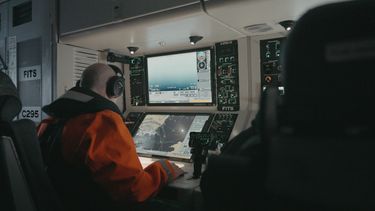
The Irish C295 MSA is unique in its class. Its various cameras and radars allow the crew to capture highly-detailed imagery. The C295 MSA features a radar horizon of 160 to 200 nautical miles in front of the aircraft, providing the crew with a clear and detailed picture of their surroundings. On top of monitoring vessels down to a 30cm resolution, the SARO can set up search patterns for search and rescue. Meanwhile, the electro-optical infrared camera installed under the nose of the aircraft allows the crew to detect, identify and classify targets. With the narrow spotter scope they can recognise specific details on a vessel, like personnel, flag state, or anchor state, while the infrared camera captures targets based on their heat signals against the cold maritime background, especially at night. In the mission system, Brian can then create an overlay of different images. With the advanced sensors, the rear crew can scan the sea surface to pick up oil spills or excess discharge. "Depending on the altitude, we are covering around a 45-metre patch,” explains Commandant Curran. “The system will determine the pollution’s depth and likely composition.".
Airbus’ medium tactical aircraft - from the CN235 to the C295
The Irish Air Corps formerly operated the Airbus-built CN235 MSA, the predecessor to the C295 MSA. For 30 years, they conducted countless maritime suveillance missions, often amassing more than 1,000 flight hours per aircraft per year - more than any other operator. Introducing the first C295 MSA in 2023 to replace the older aircraft meant a considerable leap in computational technology. Besides the improvement in the radar and camera system, the crew also had to learn how to use the new sensors that the C295 MSA is equipped with.
In order to become fully operational, the crew received extensive training at Airbus' International Training Centre in Seville, Spain. To this day, they are in constant contact with the Airbus Services Teams to get the support they need to keep their aircraft mission-ready at all times.
“From an operational perspective it’s a massive difference between the CN235 MSA and the C295 MSA in how we operate,” says Lieutenant Colonel Patrick Ridge, who is Officer Commanding No. 1 Operations Wing within the Irish Air Corps. “How we conduct our patrols at sea is very much changing and it’s very much enhanced by the new platform and the new capabilities that are on board of the platform.”
As well as state-of-the-art avionics, the Heads Up Display (HUD), and overall broader versatility of the aircraft, the advanced mission system is the greatest upgrade compared to the CN235. Previously, the process of collecting, analysing, and providing data in the form of an adjusted flight plan would take several hours. The rear crew had to fully rely on verbal communication in order to direct the pilots from vessel to vessel. Now, the SARO can supply information to the flight deck in real time. This feature has not only significantly reduced the workload of the flight crew in the cockpit and at the rear, but it has also improved efficiency, resulting in a reduction of required mission time by more than 60%.
Weathering together
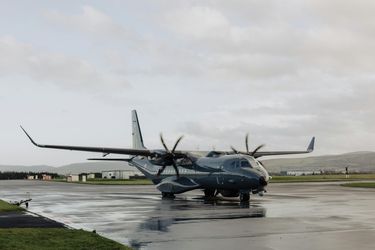
As the wind starts picking up again, the crew make their descent into Baldonnel air base. The mission was a success and they now hand over the collected data to the Mission Support Centre where the information will be analysed and disseminated to the authorities.
And just as the aircraft gets pulled into the hangar, a rainbow appears against the grey sky. On the other end? The Irish Air Corps' pot of gold: their tried-and-trusted C295 Maritime Surveillance Aircraft, waiting to go on the next mission over the unrelenting sea.
